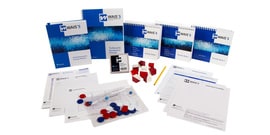Wechsler Memory Scale | Fourth Edition
WMS-IV- The Wechsler Memory Scale® | Fourth Edition (WMS®-IV) is an individually administered battery used to assess various memory and working memory abilities. Guidance on using this test in your telepractice.
- WMS-5 - Coming summer 2025! Pre-order today to take advantage of pre-publication pricing on full WMS-5 kits.
Choose from our products
-
Kits
Starter & complete kits, print & digital
7 options
from $250.00 -
Test forms & reports
Booklets, record forms, answer sheets, report usages & subscriptions
11 options
from $2.90 -
Support materials
Manuals, stimulus books, replacement items & other materials
22 options
from $4.20 -
Training
Onsite, virtual & on-demand trainings
1 option
from $2.30 -
All products
All tests & materials offered for WMS-IV
41 options
from $2.30
-
WMS-IV Complete Kit (Print)
0158895800 Qualification Level CIncludes Administration and Scoring Manual (Print), Technical Manual (Print), Stimulus Book #1 (Print), Stimulus Book #2 (Print), 25 Adult Record Forms (Print), 25 Older Adult Record Forms (Print), 25 Response Booklets (Print), Design and Spatial Addition Card Set (Print), Scoring Template and Memory Grid (Print)
-
WMS-IV Complete Kit with Softcase (Print)
0158896009 Qualification Level CIncludes Administration and Scoring Manual (Print), Technical Manual (Print), Stimulus Book #1 (Print), Stimulus Book #2 (Print), 25 Adult Record Forms (Print), 25 Older Adult Record Forms (Print), 25 Response Booklets (Print), Design and Spatial Addition Card Set (Print), Scoring Template and Memory Grid (Print) in Softcase
-
WMS-IV Flexible Approach Kit (Print)
0158896300 Qualification Level CIncludes 25 WMS-IV Flexible Approach Record Forms (Print), 25 WMS-IV Supplemental Record Forms (Print), WMS-IV Supplemental Stimulus Book (Print), and Electronic Administration and Norms Manual on CD
-
WAIS-IV Complete Kit (Print) / WMS-IV Complete Kit (Print)
0158895878 Qualification Level CIncludes WAIS-IV Complete Kit [set of Administration and Scoring, Technical Manuals (Print), 2 Stimulus Books (Print), 25 Record Forms (Print), 25 Response Booklet #1 (Print), 25 Response Booklet #2 (Print), Symbol Search Scoring Key (Print), Coding Scoring Key (Print), Cancellation Scoring Templates (Print), 9 Block Design Cubes, all in a box] and WMS-IV Complete Kit [Administration and Scoring Manual (Print), Technical Manual (Print), Stimulus Book #1 (Print), Stimulus Book #2 (Print), 25 Adult Record Forms (Print), 25 Older Adult Record Forms (Print), 25 Response Booklets (Print), Design and Spatial Addition Card Set (Print), Scoring Template and Memory Grid (Print)]
-
WAIS-IV Complete Kit with Softcase (Print) / WMS-IV Complete Kit (Print)
0158895894 Qualification Level CIncludes WAIS-IV Complete Kit with softcase [set of Administration and Scoring, Technical Manuals (Print), 2 Stimulus Books (Print), 25 Record Forms (Print), 25 Response Booklet #1 (Print), 25 Response Booklet #2 (Print), Symbol Search Scoring Key (Print), Coding Scoring Key (Print), Cancellation Scoring Templates (Print), 9 Block Design Cubes, all in a soft case] and WMS-IV Complete Kit [Includes Administration and Scoring Manual (Print), Technical Manual (Print), Stimulus Book #1 (Print), Stimulus Book #2 (Print), 25 Adult Record Forms (Print), 25 Older Adult Record Forms (Print), 25 Response Booklets (Print), Design and Spatial Addition Card Set (Print), Scoring Template and Memory Grid (Print)]
-
WAIS-IV Complete Kit with Softcase (Print) / WMS-IV Complete Kit with Softcase (Print)
0158896033 Qualification Level CIncludes WAIS-IV Complete Kit with softcase [set of Administration and Scoring, Technical Manuals (Print), 2 Stimulus Books (Print), 25 Record Forms (Print), 25 Response Booklet #1 (Print), 25 Response Booklet #2 (Print), Symbol Search Scoring Key (Print), Coding Scoring Key (Print), Cancellation Scoring Templates (Print), 9 Block Design Cubes, all in a soft case] and WMS-IV Complete Kit with softcase [Includes Administration and Scoring Manual (Print), Technical Manual (Print), Stimulus Book #1 (Print), Stimulus Book #2 (Print), 25 Adult Record Forms (Print), 25 Older Adult Record Forms (Print), 25 Response Booklets (Print), Design and Spatial Addition Card Set (Print), Scoring Template and Memory Grid (Print), in a softcase]
-
WAIS-IV Complete Kit (Print) / WMS-IV Complete Kit with Softcase (Print)
0158896084 Qualification Level CIncludes WAIS-IV Complete Kit (Print) [set of Administration and Scoring, Technical Manuals (Print), 2 Stimulus Books (Print), 25 Record Forms (Print), 25 Response Booklet #1 (Print), 25 Response Booklet #2 (Print), Symbol Search Scoring Key (Print), Coding Scoring Key (Print), Cancellation Scoring Templates (Print), 9 Block Design Cubes, all in a box] and WMS-IV Complete Kit (Print) [Includes Administration and Scoring Manual (Print), Technical Manual (Print), Stimulus Book #1 (Print), Stimulus Book #2 (Print), 25 Adult Record Forms (Print), 25 Older Adult Record Forms (Print), 25 Response Booklets (Print), Design and Spatial Addition Card Set (Print), Scoring Template and Memory Grid (Print) in a softcase]
-
WMS-IV Administration and Scoring Manual (Print)
0158895819 Qualification Level C -
WMS-IV Flexible Approach Manual Supplement (Digital)
0158896343 Qualification Level CIncludes 1 CD-ROM
-
WMS-IV Technical Manual (Print)
0158895827 Qualification Level C -
WMS-IV Q-global Administration and Scoring Manual (Digital)
A103000231399 Qualification Level COnce ordered, the digital asset is accessible by logging into Q-global and visiting the Q-global Resource Library. It is a view-only digital file.
-
WMS-IV Q-global Technical and Interpretive Manual (Digital)
A103000231398 Qualification Level COnce ordered, the digital asset is accessible by logging into Q-global and visiting the Q-global Resource Library. It is a view-only digital file.
-
WMS-IV Flexible Approach Q-global Manual and Alternate Indexes Worksheet (Digital)
A103000231415 Qualification Level COnce ordered, the digital asset is accessible by logging into Q-global and visiting the Q-global Resource Library. It is a downloadable file.
-
WMS-IV Q-global Score Report Qty 1 (Digital)
0150014562 Qualification Level C -
WMS-IV Q-global Scoring Subscription 1 Year (Digital)
QG1WM4 Qualification Level CIncludes unlimited scoring per user within an account
-
WMS-IV Q-global Scoring Subscription 3 Year (Digital)
QG3WM4 Qualification Level CIncludes unlimited scoring per user within an account
-
WMS-IV Q-global Remote-Adapted Response Booklet (Digital)
A103000231404 Qualification Level COnce ordered, the digital asset is accessible by logging into Q-global and visiting the Q-global Resource Library. It is a downloadable file.
-
WMS-IV Response Booklets Qty 25 (Print)
0158895908 Qualification Level C -
WMS-IV Adult Ages 16-69 Record Forms Qty 25 (Print)
0158895851 Qualification Level C -
WMS-IV Older Adult Ages 65-90 Record Forms Qty 25 (Print)
015889586X Qualification Level C -
WMS-IV Flexible Approach Record Forms Qty 25 (Print)
0158896319 Qualification Level CSupports LMVR Battery
-
WMS-IV Flexible Approach Supplemental Record Forms Qty 25 (Print)
0158896327 Qualification Level CSupports VRLO and LONA Batteries
-
WMS-IV/Bcse Scoring Template (Print)
0158895940 Qualification Level B -
WMS-IV Stimulus Book 1 (Print)
0158895835 Qualification Level CIncludes Brief Cognitive Status Exam, Visual Reproduction I, Logical Memory I and Spatial Addition
-
WMS-IV Stimulus Book 2 (Print)
0158895843 Qualification Level CIncludes Visual Reproduction II, Logical Memory II, Verbal Paired Associates I, Designs I, Symbol Span, Verbal Paired Associates II and Designs II
-
WMS-IV Q-global Stimulus Book 1 and Administration Directions (Digital)
A103000231412 Qualification Level CIncludes Brief Cognitive Status Exam, Visual Reproduction I, Logical Memory I and Spatial Addition. Once ordered, the digital assets are accessible by logging into Q-global and visiting the Q-global Resource Library. The stimulus book is a view-only digital file; the administration directions are downloadable.
-
WMS-IV Q-global Stimulus Book 2 and Administration Directions (Digital)
A103000231413 Qualification Level CIncludes Visual Reproduction II, Logical Memory II, Verbal Paired Associates I, Designs I, Symbol Span, Verbal Paired Associates II and Designs II. Once ordered, the digital assets are accessible by logging into Q-global and visiting the Q-global Resource Library. The stimulus book is a view-only digital file; the administration directions are downloadable.
-
WMS-IV Flexible Approach Q-global Stimulus Book and Administration Directions (Digital)
A103000231414 Qualification Level COnce ordered, the digital assets are accessible by logging into Q-global and visiting the Q-global Resource Library. The stimulus book is a view-only digital file; the administration directions are downloadable.
-
WMS-IV Flexible Approach Supplemental Stimulus Book (Print)
0158896335 Qualification Level CIncludes Logos I, Logos II, Names I and Names II
-
WMS-IV Complete Card Set (Print)
0158895932 Qualification Level CIncludes 8 Design Cards Set A, 12 Design Cards Set B, 12 Design Cards Set C, 16 Design Cards Set D, 2 Design Cards Teaching Examples, and 16 Spatial Addition cards
-
WMS-IV Spatial Addition Card Set Qty 16 (Print)
0158895924 Qualification Level C -
WMS-IV Design Card Set A Qty 8 (Print)
0158895967 Qualification Level C -
WMS-IV Design Card Set B Qty 12 (Print)
0158895975 Qualification Level C -
WMS-IV Design Card Set D Qty 16 (Print)
0158895991 Qualification Level C -
WMS-IV Design Card Set C Qty 12 (Print)
0158895983 Qualification Level C -
WMS-IV Design Card Sets A-D & Demonstration Qty 50 (Print)
0158895916 Qualification Level CIncludes 8 Design Cards Set A, 12 Design Cards Set B, 12 Design Cards Set C, 16 Design Cards Set D, and 2 Design Cards Demonstration Items in a bag
-
WMS-IV Design Card Set Demonstration Qty 2 (Print)
0158895959 Qualification Level C -
Memory Grid (Print)
0158234472 Qualification Level CIncludes 2011 Memory Grid update for NEPSY-II and WMS-IV
-
WMS-IV Scoring Assistant (Digital)
0158896017 Qualification Level CIncludes 1 CD-ROM with unlimited scoring
-
WMS-IV Report Writer (Digital)
0158896092 Qualification Level CIncludes 1 CD-ROM with unlimited scoring with interpretive narrative
-
WMS-IV Training CD (Digital)
0158896289 Qualification Level CIncludes WMS-IV Training on administration, scoring and interpretation on 1 CD-ROM
Overview
- Publication date:
- 2009
- Age range:
- 16:0 to 90.11
- Scores/interpretation:
- Contrast Scores
- Qualification level:
- C
- Completion time:
- Varies based on battery
- Administration:
- Paper or Q-interactive®
- Scoring options:
- Manual scoring or Q-global®
- Telepractice:
- Guidance on using this test in your telepractice
Product Details
WMS-5 is coming soon!The Wechsler Memory Scale® | Fourth Edition (WMS®-IV) contains seven subtests that are divided into Auditory Memory, Visual Memory, Visual Working Memory, Immediate Memory, and Delayed Memory domains. A brief cognitive screener is included to quickly evaluate significant cognitive impairments. WMS-IV was co-normed with the WAIS®-IV (2008-2009). |
|
WMS-IV Flexible Approach Batteries |
Standard WMS-IVThis consists of the 7 primary subtests that comprise the full WMS-IV battery and provide coverage for all the memory indexes. |
LMVR and LMDELMVR, consists of Logical Memory (LM) and Visual Reproduction (VR), and LMDE consists of Logical Memory and Designs (DE). |
VRLO and LONAThis set of alternate batteries focuses on using supplemental subtests for assessing visual memory, which is a difficult construct to measure. |
OAAThe OAA battery was developed in the standard WMS-IV as a shorter battery for use with older adults ages 65 to 90. |
|
LMDE and OAA batteries can be collected using standard WMS-IV record forms and an accompanying worksheet provided in the WMS-IV Flexible Manual. Sample ReportsThe following scoring information and samples are available for WMS-IV. |
Resources
|
The following resources are available for WMS-IV. Product Overview |
Case Studies & Research |
Q-interactive
WMS-IV on Q-interactive at a Glance:Available With
Subtest Pricing Scoring and Reporting
Materials Needed
Benefits of WMS-IV on Q-interactive
How Can I Buy WMS-IV on Q-interactive?New customers:Annual Q-interactive licenses can be purchased using our online order form or by calling Customer Support at 1-800-627-7271. See the Q-interactive pricing tab for more information on license options. Current Q-interactive customers:If you want to add the WMS-IV to your account, visit our online order form and select the "Add test(s) to existing account" option. You may also call Customer Support at 1-800-627-7271. |
FAQs
|
Frequently asked questions follow. Click on a question to see the response.
|
Webinars
|
The following training events are available for WMS-IV. |



